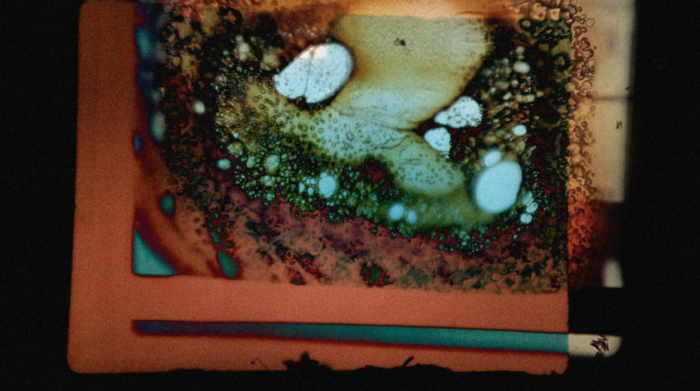
Universal Leader (2020) by Orit Ben-Shitrit
CROSSROADS 2020 — program 7
what do you get when you fall in love?
program online August 28–September 30
program community partner: Canyon Cinema Foundation
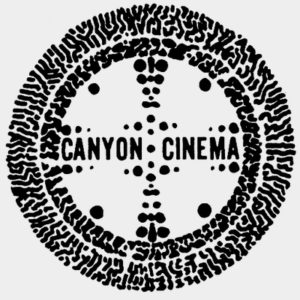
Give us your songs. Give us your smells. We’ll give you everything. Once upon a time there was life. Opening with the late great Luther Price’s A Patch of Green, the films in this program explore filmic materiality and collective fantasy, the repulsive charm of evanescent and even olfactory celebrity, the allure of the commodity and the gloss of the spectacle, lifestyle branding, the modular conformity of global industry and the banality of racialized human databases. Tentative gestures toward romance are extended, with mixed results. There is always something there to remind me.
This program is dedicated to the memory of filmmaker Luther Price (1962–2020).
SCREENING: A Patch of Green (2004–2005) by Luther Price (US); Universal Leader (2020) by Orit Ben-Shitrit; Thorax (2019) by Siegfried A. Fruhauf; Curious Fantasies (2019) by Jesse McLean; International Face (2019) by Natalie Tsui; Global Industries (2018) by Phillip Andrew Lewis; Billy (2019) by Zachary Epcar; Horsey (2018) by Frédéric Moffet; Eastern State (2019) by Talena Sanders
TRT: 55 minutes
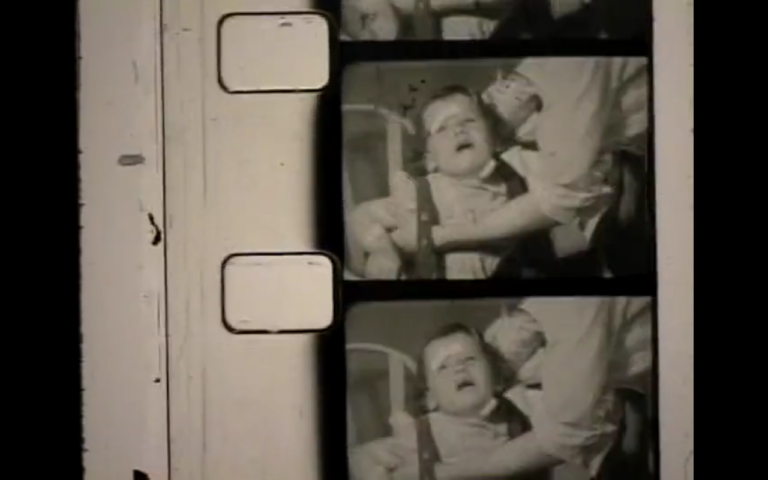
A Patch of Green (2004–2005) by Luther Price
Shots of children, animals and fire evoke both caring and destruction. (Luther Price)
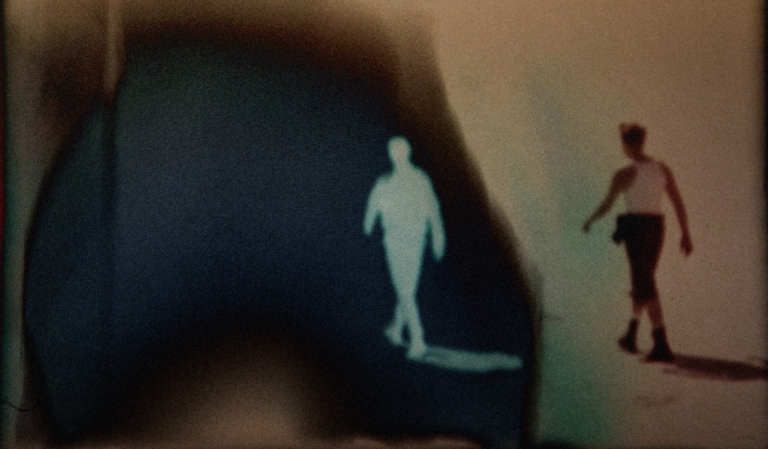
Universal Leader (2020) by Orit Ben-Shitrit
Universal Leader refers to the countdown on analogue film stock, while simultaneously addressing the current state of leaders in the world. The film uses poetry-like film semantics to travel a sociopolitical path between gun violence, leader figures, war images and subsequent refugees. It is composed of physically manipulated 24 frames per second, using bleach etching, watercolors, oil pastels, markers and cuts using sharp objects. At times, the film which is fed through a projector is manually slowed down until it burns. The suggested impact of the leader figure initiates a physical cataclysm to the body of the film. (Orit Ben-Shitrit)

Thorax (2019) by Siegfried A. Fruhauf
[…] And so commences an imagined dolly shot into the bloodless, post-humanoid body, travelling into an abstract space that occasionally seems to become concrete of its own accord before dissolving back into glistening streaks and ultimately, wide expanses: a cinematic worm hole leading behind the images, where the sluggish human eye is and must be subject to a trick of light arrangements. […] It is said one must not look into the sun, to prevent a child’s visual urge to discover from damaging eyesight. Sharing affinities with Fruhauf´s early film Sun (2003), Thorax in contrast fuels adolescent irrationality and curiosity. At some point, we look with wide open eyes into the dazzling light, accompanied by threatening clusters of sound and subtly arranged provocative sounds. A wildly mesmerizing light. The light at the end of the tunnel. (Sebastian Höglinger)

Curious Fantasies (2019) by Jesse McLean
The language and imagery related to celebrity perfumes (both descriptive and visual) are a starting point to think about consumer desires and the corruptness of branding. Give us your songs, your smells and we will give you everything. The rich get richer, everyone smells poorer. (Jesse McLean)
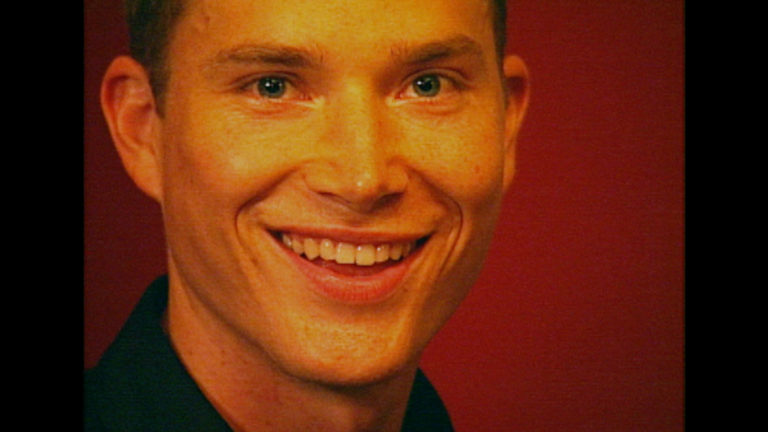
International Face (2019) by Natalie Tsui
A meditation on race, queer diaspora, and image classification systems, International Face is an autoethnographic essay film that attempts to situate romantic experiences and visual observations of a queer non-binary person of color within a stock video footage archive. (Natalie Tsui)

Global Industries (2018) by Phillip Andrew Lewis
Global Industries (2018) repurposes the banality of modular office cubicles and reimagines a product advertisement in an abstract montage of animated pans. The film is made entirely from appropriated imagery from an office furniture catalog. (Phillip Andrew Lewis)
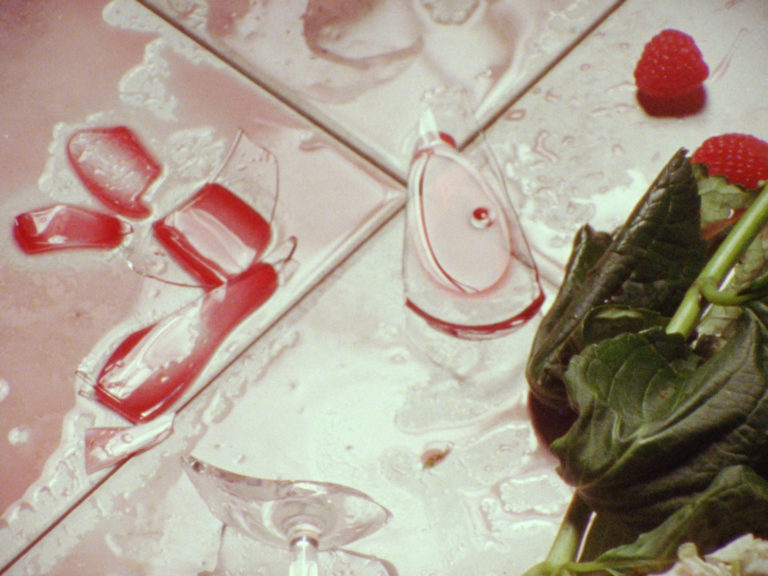
Billy (2019) by Zachary Epcar
The reenactment of a scene from a primetime soap opens this domestic psychodrama, an anxious look into the horrors of interior decoration and the boundless entanglement of things. (Zachary Epcar)
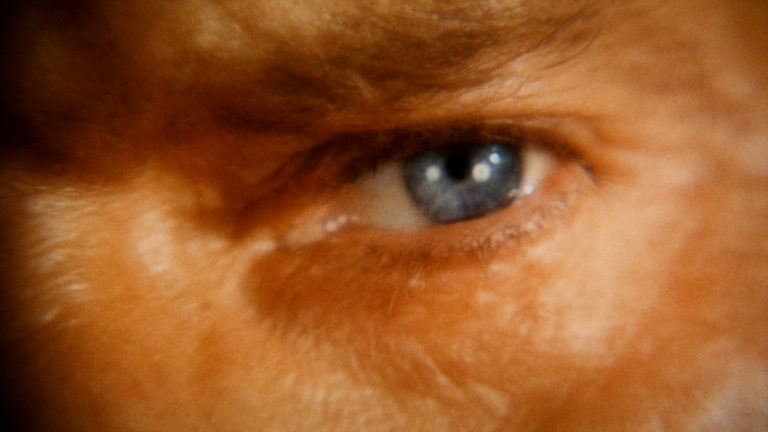
Horsey (2018) by Frédéric Moffet
“Horses are lucky, they’re stuck with the war same as us, but nobody expects them to be in favor of it, to pretend to believe in it.” An allegory recycling images from the past, still relevant to the present moment. (Frédéric Moffet)
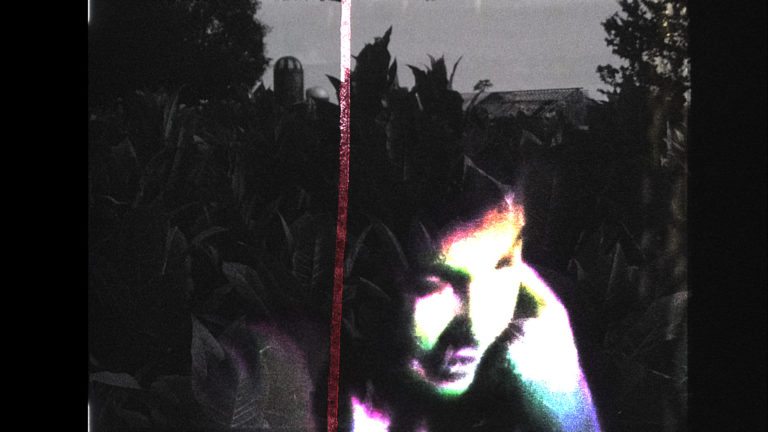
Eastern State (2019) by Talena Sanders
Stemming from a found archive of decades of footage documenting the lives of the patients and employees of one of the oldest mental health institutions in the US, Eastern State seeks the moments when the source materials start communicating something outside their intended purpose. Bringing these images into dialogue with Barbara Loden’s 1970 film Wanda through digital video corruption, VHS artifacting, stroboscopic effects, direct animation, and overlays, this found footage collage film considers the fidelity of nonfiction media to represent lived experiences of isolation.
*flicker warning (Talena Sanders)

Luther Price (US; 1962–2020) studied Sculpture and Media/Performing Arts at the Massachusetts College of Art and Design. His Super-8mm and 16mm film works, slide projections, performance works and sculptural installations have been exhibited worldwide. “I told myself that if I were going to make a films I would have to be completely honest. Because it’s a medium where you can lie very easily. And you can change truth. I wanted to keep truth. […] I want to make true films. I don’t care if it hurts me. People exploit each other anyway. If you exploit yourself you leave no room to be exploited by someone else. No one can hurt me. No one can say anything about me because I’ve already said it. I’ve already given them the dirt. We always have the ability to redeem ourselves…” (Luther Price: “I Want to Keep Truth…” Big As Life: An American History of 8mm Films)
 Orit Ben-Shitrit (US/Israel) is a visual artist, photographer and filmmaker. Ben Shitrit creates elastic worlds in still and moving image works. Her time-based works consist of site-specific theatrical narratives, which are often presented as projections. Working with photography, film, video and choreography, Ben-Shitrit utilizes movement and bodies to implicate the powers that be, their mechanisms of domination, and their effect—the potential for violence. Pulling from many historical and literary sources, Ben-Shitrit addresses the personal and contemplates the national in textured imagery. She engages in three main topical themes: abstract systems of political, religious and economic control; cycles of violence in the Middle East and conflicted beings trapped in bodies. She received her MFA from Hunter College in 2010 and is based in Brooklyn and San Francisco.
Orit Ben-Shitrit (US/Israel) is a visual artist, photographer and filmmaker. Ben Shitrit creates elastic worlds in still and moving image works. Her time-based works consist of site-specific theatrical narratives, which are often presented as projections. Working with photography, film, video and choreography, Ben-Shitrit utilizes movement and bodies to implicate the powers that be, their mechanisms of domination, and their effect—the potential for violence. Pulling from many historical and literary sources, Ben-Shitrit addresses the personal and contemplates the national in textured imagery. She engages in three main topical themes: abstract systems of political, religious and economic control; cycles of violence in the Middle East and conflicted beings trapped in bodies. She received her MFA from Hunter College in 2010 and is based in Brooklyn and San Francisco.
 Siegfried A. Fruhauf (Austria) 1991—1994: Training as commercial manager. 1995—2010: Lived and worked in Linz and Heiligenberg. Studied experimental visual design at the University of Artistic and Industrial Design in Linz where he first came into contact with the Austrian Film Avantgarde. 2002: Supporting Award for Filmart by the Austrian Federal Chancellery. 2018: Österreichischer Kunstpreis: Film. Since 2001 organization of film and art events. Since 2009 lecturer at the University of Artistic and Industrial Design, Linz. Numerous works and shows in the area of film, video and photography. Participation in various international film festivals (Festival de Cannes—Semaine Internationale de la Critique, International Filmfestival of Venice—Section Nuovi Territori, Sundance Film Festival…). Member of sixpackfilm. Lives and works in Vienna and Heiligenberg since 2010.
Siegfried A. Fruhauf (Austria) 1991—1994: Training as commercial manager. 1995—2010: Lived and worked in Linz and Heiligenberg. Studied experimental visual design at the University of Artistic and Industrial Design in Linz where he first came into contact with the Austrian Film Avantgarde. 2002: Supporting Award for Filmart by the Austrian Federal Chancellery. 2018: Österreichischer Kunstpreis: Film. Since 2001 organization of film and art events. Since 2009 lecturer at the University of Artistic and Industrial Design, Linz. Numerous works and shows in the area of film, video and photography. Participation in various international film festivals (Festival de Cannes—Semaine Internationale de la Critique, International Filmfestival of Venice—Section Nuovi Territori, Sundance Film Festival…). Member of sixpackfilm. Lives and works in Vienna and Heiligenberg since 2010.
Jesse McLean (US): A primary focus of all my work is the power—and the failure—of the mediated experience to bring people together. I am motivated by a deep curiosity regarding human behavior and the ways intimacies and connections are formed in an age of mediated experience. Recent projects explore the immersion into digital culture and the fraught relationships people have with technology we both rely on and resent, and in contrasting the finite capacities of the nonhuman with infinite human desires.
 Natalie Tsui (US) is queer artist and filmmaker whose work investigates the links and ruptures between personal and collective identities, narratives, and memories through autoethnography, installation, performance and social practice. Addressing the problematic legacy of cinema and photography as mediums that erase, distort and totalize the experience of the “other,” Tsui’s artistic practice explores alternate modes of visual imaging and representation. Tsui holds a BA in Film Studies and English from UC Berkeley and an MFA in Cinema from San Francisco State University. They have lectured at San Francisco State University and San Francisco Art Institute and worked as a video editor for the San Francisco Museum of Modern Art. Their work has screened at the Contemporary Jewish Museum, Frameline, ICDOCS, Museu de Arts Moderna of Rio de Janiero, Shapeshifters Cinema and the San Francisco Museum of Modern Art. They were a Flaherty Film Seminar Fellow, NYFF Artist Academy Fellow, Queer Art Mentorship Fellow, and a Princess Grace Film Awardee.
Natalie Tsui (US) is queer artist and filmmaker whose work investigates the links and ruptures between personal and collective identities, narratives, and memories through autoethnography, installation, performance and social practice. Addressing the problematic legacy of cinema and photography as mediums that erase, distort and totalize the experience of the “other,” Tsui’s artistic practice explores alternate modes of visual imaging and representation. Tsui holds a BA in Film Studies and English from UC Berkeley and an MFA in Cinema from San Francisco State University. They have lectured at San Francisco State University and San Francisco Art Institute and worked as a video editor for the San Francisco Museum of Modern Art. Their work has screened at the Contemporary Jewish Museum, Frameline, ICDOCS, Museu de Arts Moderna of Rio de Janiero, Shapeshifters Cinema and the San Francisco Museum of Modern Art. They were a Flaherty Film Seminar Fellow, NYFF Artist Academy Fellow, Queer Art Mentorship Fellow, and a Princess Grace Film Awardee.
 Phillip Andrew Lewis (US) is an interdisciplinary artist who lives and works in Pittsburgh. His creative research often responds to historical events, psychology and phenomenology. This work consistently examines duration, perceptual limits and attentive observation. Lewis is actively involved in collaboration with artists and groups and has exhibited his work both nationally and internationally. In 2012 he received a Creative Capital Grant for his ongoing long-term project SYNONYM. He has received support for his research from Headlands Center for the Arts, BlackCube, Sabrina Merage Foundation, Culture and Animals Foundation, Center for Creative Photography, Foundation for Contemporary Art in New York, Fathomers, Bemis Center for Contemporary Art, Midway Contemporary Arts Fund, Tennessee Arts Commission and The Pittsburgh Foundation.
Phillip Andrew Lewis (US) is an interdisciplinary artist who lives and works in Pittsburgh. His creative research often responds to historical events, psychology and phenomenology. This work consistently examines duration, perceptual limits and attentive observation. Lewis is actively involved in collaboration with artists and groups and has exhibited his work both nationally and internationally. In 2012 he received a Creative Capital Grant for his ongoing long-term project SYNONYM. He has received support for his research from Headlands Center for the Arts, BlackCube, Sabrina Merage Foundation, Culture and Animals Foundation, Center for Creative Photography, Foundation for Contemporary Art in New York, Fathomers, Bemis Center for Contemporary Art, Midway Contemporary Arts Fund, Tennessee Arts Commission and The Pittsburgh Foundation.
 Zachary Epcar (US) is a filmmaker whose work has screened at the New York Film Festival, Toronto International Film Festival, International Film Festival Rotterdam, Museum of Contemporary Art Chicago, Pacific Film Archive, Ann Arbor Film Festival, Crossroads, Onion City, 25 FPS, Images Festival and elsewhere. He is a co-programmer of Light Field, an annual exhibition of experimental cinema in San Francisco.
Zachary Epcar (US) is a filmmaker whose work has screened at the New York Film Festival, Toronto International Film Festival, International Film Festival Rotterdam, Museum of Contemporary Art Chicago, Pacific Film Archive, Ann Arbor Film Festival, Crossroads, Onion City, 25 FPS, Images Festival and elsewhere. He is a co-programmer of Light Field, an annual exhibition of experimental cinema in San Francisco.
 Frédéric Moffet (Canada) is a media artist, educator, editor and cultural worker. He lives between Montreal and Chicago. His work explores the slippery territory between history, lived experience and fantasy.
Frédéric Moffet (Canada) is a media artist, educator, editor and cultural worker. He lives between Montreal and Chicago. His work explores the slippery territory between history, lived experience and fantasy.
 Talena Sanders (US): I am an artist and filmmaker who creates experimental documentary films that reflect the wild complexity and strange poetry of lived experience. Expanding and challenging mainstream documentary conventions is at the center of my work. I like gaps and mystery and opening up more questions than giving easy answers. Sometimes my work is about my own experiences, sometimes it’s about artists and people I admire—trailblazing women and queer people. My work is collage-like, weaving together materials from many different sources and angles. I record on 16mm most often, in part for the way that material destabilizes a viewer’s sense of time, blurring the line between found footage and what is contemporary. I am proud to be a film educator, serving as Assistant Professor of Communication and Media Studies at Sonoma State University.
Talena Sanders (US): I am an artist and filmmaker who creates experimental documentary films that reflect the wild complexity and strange poetry of lived experience. Expanding and challenging mainstream documentary conventions is at the center of my work. I like gaps and mystery and opening up more questions than giving easy answers. Sometimes my work is about my own experiences, sometimes it’s about artists and people I admire—trailblazing women and queer people. My work is collage-like, weaving together materials from many different sources and angles. I record on 16mm most often, in part for the way that material destabilizes a viewer’s sense of time, blurring the line between found footage and what is contemporary. I am proud to be a film educator, serving as Assistant Professor of Communication and Media Studies at Sonoma State University.